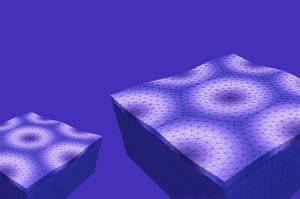Accelerating nonlinear MEMS simulations with the harmonic balance method
See how harmonic balance is leveraged for solving nonlinear periodic problems in frequency domain for quicker, more precise results without transient analysis.
Rapid Prototyping in MEMS Ultrasound
A look into how MEMS ultrasound technology is developed in practice, from electromechanical modeling to acoustic testing and rapid prototyping.
Introduction to the guest
Dr. Martin Angerer is a Post-doctoral Research Engineer at The University of British Columbia, specializing in MEMS ultrasound technology. With extensive experience in both industry and applied academic research, Martin has worked on modeling, rapid prototyping, process optimisation and testing of MEMS sensors and acoustic transducers.
In this episode...
We explore how ultrasound transducers are developed—from the fundamental electromechanical conversion, to MEMS-based prototypes—to the simulation workflows that support them. We cover how finite element modeling, analytic approaches and rapid iteration play into the design of sensors, what the current simulation strengths and limitations are, and where things are headed.
Electromechanical converter: turns electrical energy into acoustic waves and back, enabling transmit and receive.
Beyond medical imaging: nondestructive testing, flow sensing, particle detection (air/fluids), and high-power uses like ultrasonic welding.
Micromachined devices (CMUT/PMUT-style membranes) offer compact form factors and new array designs compared to bulk piezo ceramics.
Layered polymer MEMS enables fast, application-specific prototypes and 3D integration—useful when standard parts don’t fit the acoustic spec.
Starts with analytic/equivalent-circuit models, then moves to finite-element multiphysics to couple electro-mechanical-acoustic behavior and set design parameters.
Rapid fabrication is tempting, but unguided iteration wastes time; disciplined modeling narrows the design space before building.
Membrane geometry, layer thicknesses, cell diameter and packing, array layout, and coupling to the medium determine field strength and bandwidth.
Micron-scale features must predict macro acoustic fields; arrays jump from dozens to thousands of elements—driving model size and runtime.
Listen to the full episode on YouTube
0:00 Introduction
1:08 What is an ultrasound transducer
1:37 What do they do in practice
2:30 Where are they used
3:54 Micromachine transducers
6:15 What makes polymer-based MUTs special
8:00 The development process of a sensor
9:37 Design exploration
12:26 State of simulation in the field
14:30 Magic wand to improve one area
16:11 Emerging technologies in the field
18:03 Opportunities of AI/ML
19:36 Particular interest of Martin
21:31 Outro
Learn more about the topics

Blog
Enhancing MUT design and performance with Quanscient Allsolve
Designing high-performance MUT arrays is challenging due to limited simulation capabilities. See how Allsolve has changed this.
Read the full article →
%20(1).jpg?width=300&name=podcast%20resources%20(3)%20(1).jpg)
Webpage
Array-scale cloud based MUT simulations
Our dedicated webpage for Quanscient Allsolve and its capabilities with micromachined ultrasound transducers.
Open the page →

Webinar PDF summary
Accelerating MUT design with cloud-based multiphysics simulation
Download the PDF summary covering case examples of design optimization of CMUT and PMUT devices with Quanscient Allsolve.
Download the PDF summary →
